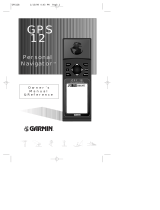
5
Introduction
Table of Contents
Introduction....................................1-7
Registration ........................................ 1
Warnings and Cautions ...................... 2
FCC Compliance Statement ............... 3
Features.............................................. 4
Table of Contents ............................... 5
“How To” Index.................................. 6
GPS 76 Unit Features ......................... 7
Section One: Getting Started .......8-20
Installing the Batteries ........................ 8
Installing the Lanyard......................... 9
Interface Keys................................... 10
Main Pages ....................................... 11
Using the Built-In Simulator............. 12
Using the Interface Keys................... 13
Entering Data .............................. 14-15
Basic Navigation.......................... 16-20
Initializing the GPS 76...................... 18
Section Two: Reference ..............21-57
Initializing the GPS Receiver........ 21-22
GPS Information Page ................. 23-25
Map Page.......................................... 26
Map Page Options ....................... 26-31
Pointer Page .................................... 32
Highway Page.............................. 33-35
Main Menu Page.......................... 35-61
Trip Computer....................... 35-36
Tracks....................................37-38
Waypoints .................................. 39
Creating Waypoints .................... 40
Editing Waypoints ...................... 41
Points of Interest......................... 42
Cities .......................................... 42
Routes ...................................43-47
Proximity.................................... 47
Celestial.................................48-50
MapSource Info .......................... 51
Setup Menu- General Tab ...... 52-53
Setup Menu-Time Tab ................ 53
Setup Menu-Units Tab................ 54
Setup Menu-Location Tab...... 54-55
Setup Menu-Alarms Tab ............. 56
Setup Menu-Interface Tab........... 57
Appendices.................................58-75
Appendix A: Specifi cations............... 58
Appendix B: Wiring & Interfacing.... 59
Appendix C: Time Offsets ................ 60
Appendix D: Map Datums........... 61-62
Appendix E: Navigation Terms .... 63-64
Appendix F: Messages .................65-66
Appendix G: Loran TD................ 67-68
Appendix H: Accessories .................. 69
Appendix
I: Index ...................... 70-74
Appendix
J: Warranty ..................... 75
190-00229-00.indd 07/25/01, 11:21 AM5




















